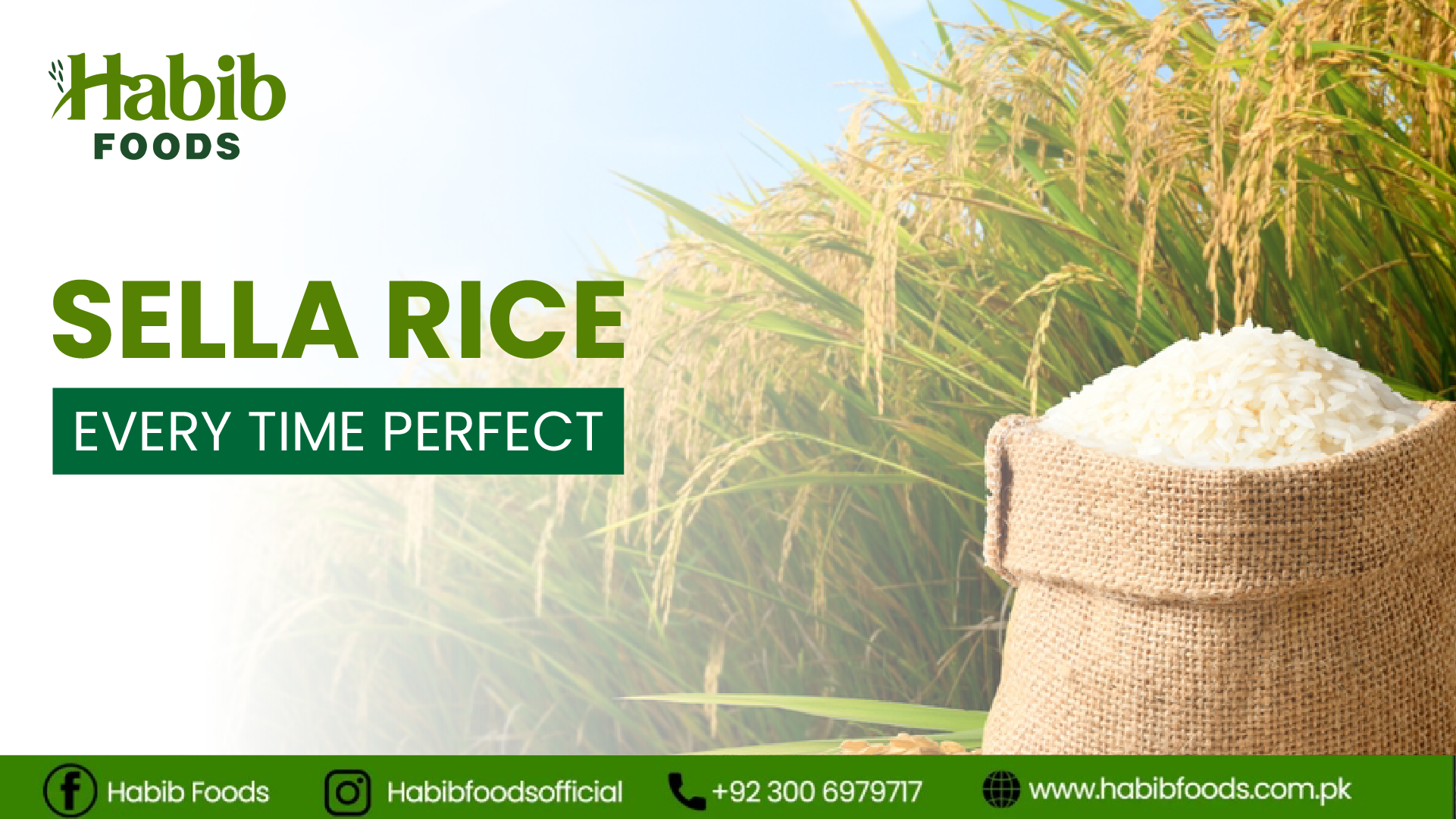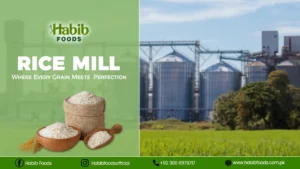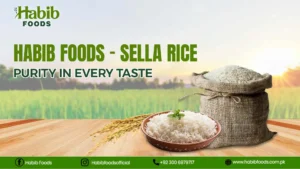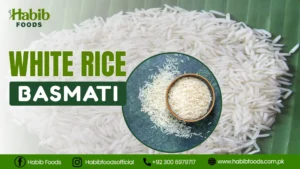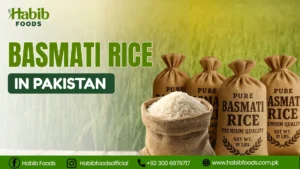Habib Foods has been offering a variety of rice for many years, but people still seem confused when choosing between Sella rice and Basmati, and wonder which one is the better option. Although the raw paddy remains the same, the different processing methods alter the quality, texture, and even the nutritional value.
Eating a good Biryani is love, but selecting the right rice to achieve a long, quality texture where each grain is separate makes making Biryani really daunting, especially for those just starting to cook with basmati rice. Many experts fail to manage it, as even a slight variation in water quantity can significantly impact the quality you expect.
However, after Milling, Basmati rice becomes harder and stronger through steaming and drying. Even when you cook rice with the wrong amount of water, the grains will still absorb water and stay separate, giving you a good texture for cooking.
Not just cooking, but when we talk about the healthiest option, steaming with husk makes sella a better choice. In this blog, we explore how Sella is better than Basmati, the reasons behind that, and why it is a healthier option. So, without further ado, let’s examine the better choice to add to your daily life.
Same Paddy to Different Result : Processing of Basmati and Sella Rice
Both Sella rice and Basmati rice start their life from the same paddy in the fields; they are cultivated through the same process in similar fertile soil to produce aromatic rice of both varieties. However, the processing makes a significant difference in the Sella rice price and the basmati price, too.
Basmati Rice Processing
Regular Basmati:
Regular Basmati, once harvested, is processed after sun drying. It is dehusked with Milling and polished to maintain its natural fragrance, slender grains, and fluffy texture, unlike regular Basmati.
Premium Basmati:
Premium Basmati rice is similar to regular Basmati, but after Milling, it is stored for 12-18 months without any polishing. During this time, the rice’s colour changes due to ageing, transforming it into Premium Basmati. This process offers premium export-quality rice with enhanced fragrance, aroma, and texture, making it popular among chefs and households for preparing the finest White Rice Basmati for both commercial and family gatherings.
Sella Rice Processing
The paddy is initially the same from cultivation to harvesting, but the processing makes a real difference in terms of health, texture, quality, and even fragrance. It is not like Basmati paddy. The paddy is soaked in normal water for a few hours, then, with the husk still on, it goes through a steaming process using large boilers. The boiling process with the husk turns its colour to a yellowish, golden hue. At a specific stage, under quality control, the rice is steamed and then sent to an advanced drying machine. The drying machines make the texture of the rice hard. After that, the milling process begins, during which the husk is removed. After Milling, the rice is ready to reach your kitchen.
Processing made a real difference in the cooking experience, in terms of flavour and even the nutritional values.
Characteristics of Regular, Premium Basmati, and Sella Rice
Regular Basmati Rice
- Naturally long but distinct fragrance.
- Soft, fluffy after cooking.
- More natural from field to plate.
- Slightly breakable compared to other types.
- Best for every daily meal.
- Pure white shiny color.
- Less fiber. Cheap in price.
- Pure white color with natural shine.
- Shorter shelf life compared to Sella.
Premium Basmati rice
- High in taste and aroma.
- Long grain with fluffy texture.
- Milky white color due to aging.
- Ideal for occasions and festivals.
- After high-quality grading, it is best for export.
- Higher in price compared to regular Basmati.
- Complete processing, including aging.
- Luxurious rice quality, favored by chefs.
- Better than regular Basmati; no broken grains.
Sella rice
- Superior aroma, taste, and texture.
- Absorbs more water compared to Basmati.
- High soaking time, 1 to 2 hours.
- High-quality grading.
- Natural yellow-golden color.
- Ideal for treats, festivals, and gatherings.
- Best for commercial use.
- More nutrition than Basmati with husk boiling.
Significant Difference Between Basmati and Sella Rice
| Features | Sella Rice | Basmati Rice |
| Nutritional value | High | Low |
| Processing | Soak, steamed, dried, milled, and ready to serve | Milling, stored till 12-18, then serve you as premium basmati |
| Texture | Fluff each grain separately | Fluffy |
| More water resistance | yes | No |
| Grain Color | Yellowish Golden | Milky white after aging |
| Cooking experience | Easy to cook with more absorbing water capacity | Give a hard time to new chefs |
| Cooking time | 20- 225 minutes | 15-20 minutes |
| Soaking time | 1-2 hours | 15-30 minutes |
| Pricing | Expensive but affordable, the premium Basmati | Most expensive when you get premium quality, but if you switch to regular, it will be affordable |
| Best For | Commercial, catering, wedding, festive | Regular meals and festive |
You can get affordable Sella and Basmati rice if you find a rice mill like Habib Foods that offers competitive prices on all varieties, compared to retail shops or any wholesaler. A rice mill provides you with fresh grain directly from the farm, maintaining quality and freshness. You also have a lot of options for rice in different colors and sizes, allowing you to choose according to your budget.
Which one is the best, Sella or Basmati?
Now you better understand which rice quality is best: Sella and Basmati have different market values. Used worldwide as a favorite rice variety initially, from the same paddy, both offer good storage, aroma, and taste; however, processing changes in terms of nutrition, quality, and strength. Sella is more beneficial if you choose between the two.
- Nutritional value: Sella is more nutritious than Basmati.
- Strong grain: Sella offers a stronger grain due to drying before Milling.
- Water absorption: Sella has a higher capacity to absorb water without spoiling its texture.
- Non-Sticky Texture: Sella offers a non-sticky texture with each separate grain because of steaming
- For Bulk Cooking: Sella Rice is best when it has strength and extra-long grains, ideal for catering services and restaurants for cooking.
Choice depends on your Need
In terms of texture, fragrance, and quality, both rice types are the champions and receive favoritism certificates for the yummiest Biryani and pulao among all varieties of rice. However, it depends on your preference: if you want a healthier option, go for Sella; if you prefer more flavor, choose Basmati. For home use, Basmati is perfect, but for large gatherings, Sella is easier to handle compared to Basmati. If you are an experienced chef, you can also go with Basmati.
So it’s not just a debate, Otis, all about your needs that force you to find a rice mill near me. The Habib Foods is actually offering a rice mill pricing on your fingertips by offering various rice varieties, including Sella and Basmati, to provide a delight while eating a rice meal within your budget.
Frequently Asked Question(FAQs)
What is the main difference between Regular, Premium, and Sella Basmati rice?
- Regular Basmati: white in color, aromatic, soft, and perfect for daily use
- Premium Basmati: Milky white in color, with no broken grains, traditional aroma, taste, and texture, perfect for the festive season.
- Sella Rice: Golden yellow color, hard in texture, fluffy and long after cooking, more nutritious than Basmati, perfect for bulk cooking.
Which Basmati rice is best for Biryani?
Sella Basmati rice comes from the same paddies; initially, it’s Basmati, but processing makes it Sella, which is the best for Biryani, especially when you talk about boiled Karachi-style biryani, known worldwide for its fluffy, long, and separate grains.
Is Sella Basmati rice healthier than regular Basmati?
Yes, due to parboiling with husk, the seller’s rice retains more fiber, minerals, and vitamins, making it a healthier option than normal Basmati.
Final Words
Finally, you know all about Basmati, whether it’s regular or premium, and the high-quality Sella initially. All are the same, but differences in processing make them vary in texture, nutritional value, strength, and aroma. It also affects the rice price in Pakistan: Sella rice is more expensive than regular Basmati, but premium Basmati is even higher due to aging differences. But don’t worry, with Habib Foods Rice Mill, you get all rice varieties, including brown Basmati rice, at very affordable prices.

